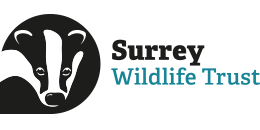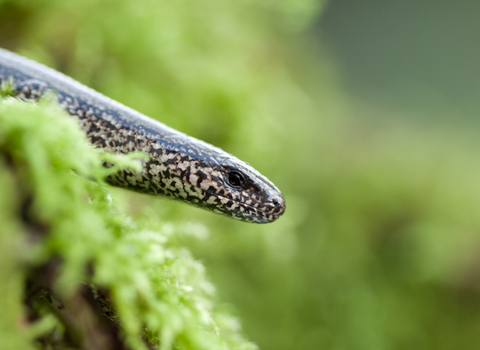Join the Surrey Species Search this summer!
Through our new pilot project, we're asking people to get outside and keep an eye out for five key species this summer.
We’re introducing local people to the wonders of wildlife by asking them to look for and record the presence of five key species including a mammal, a bird, a reptile, a plant and an insect which typify the range of Surrey’s wildlife - but could disappear if nature’s decline continues.
By going on a Surrey Species Search in your garden or a local community space such as a woodland, playing field or churchyard, you might spot bats, Swifts, Peacock butterflies, Oxeye Daisies and Slow-worms!
By using our specially-designed app, easily downloadable to any smartphone, you can record and identify these species and report their numbers and locations. The data on species sightings in Surrey will be fed to the Surrey Biodiversity Information Centre (SBIC), a vital body which enables conservationists to understand the changing distribution and abundance of native plants and animals and formulate conservation strategies for them.
Getting started & using the app
Step 1: Download the ArcGIS Survey123 app from the App Store, open the app and click the 'Continue without signing in' button. To fully record your findings, you will need to allow the app access to Location Services and the Camera
Download ArcGIS Survey123 on Android
Download ArcGIS Survey123 on IOS
Step 2: Return to this webpage on your device and click the button below
Step 3: Open the ArcGIS Survey 123 app on your device - Five2Find should begin installation
Step 4: Watch our short video to find out more about the species you’ll be spotting, and then begin your search!
Why is species recording important?
Over time, the information gathered through Surrey Species Searches will help improve, protect or connect the local green spaces that are most important for wildlife. Surrey Wildlife Trust works with local people and communities across the county to help them reap the benefits of learning about, creating, and caring for wild places – from window boxes and gardens to local parks, playgrounds and nature reserves.
Learn all about the species you’ll be spotting below...
Bats
Bat ID (https://www.youtube.com/watch?v=OiRyjgNoYg4)
Wildlife Watch
Britain is home to 18 species of bat, the largest being the noctule which weighs as little as four £1 coins, and the smallest, the pipistrelle, weighing as little as a 2p coin, is known to gobble up more than 500 insects in an hour!
Identifying bats
You won't be able to hear bats' ultrasonic call without a bat detector. These can be borrowed or purchased and many will identify the species of bat automatically by its call.
Where to see bats
Bats are most active in the summer months when they come out of hibernation, hunt insects, give birth and raise young, and the best time to see them is around sunset or sunrise when it is warm and dry.
While some bats fly relatively high, others are found closer to the ground – not venturing far above the trees or flying low over grassland and water.
Interested in taking your bat recording to the next level? You can borrow a bat detector from us for FREE through our Wildlife Recording Kits page.
Swifts
Swift ID (https://www.youtube.com/watch?v=_VxwBABSHtI)
Lincolnshire Wildlife Trust
Swifts spend most of their lives soaring high in the sky, only ever landing to nest. They are easy to spot as they look like an arrow whirling through the sky, and often fly in groups. Swifts spend the winter in Africa but travel to Britain every year in April and May.
Identifying Swifts
The Swift is dark brown all over, often appearing black against the sky, with a small, pale patch on its throat. They're larger than Swallows and martins, with long curving wings that make them look a bit like a boomerang when in the air. Swifts are very sociable and can often be spotted in groups wheeling over roofs and calling to each other with high-pitched screams. Unlike Swallows and martins, Swifts are almost never seen perching.
Where to see Swifts
Swifts can be found across the UK and are often seen flying high above towns and villages as they rely on buildings for nesting.
Peacock butterflies
Peacock butterfly ID (https://www.youtube.com/watch?v=e4f8el4vFdM)
Butterfly Conservation
On the wing throughout the year and overwinters as an adult, the Peacock is a very common butterfly and a regular visitor to our gardens. The caterpillars feed on common nettles.
Identifying Peacock butterflies
The Peacock is deep-red with black spots and blue 'eyespots' on both the forewings and hindwings. Its underside is dark brown, making the wings look like dead leaves.
Where to see Peacock butterflies
Peacocks regularly visit gardens, where they feeds on buddleia and other flowers. They can also be found in the shelter of woodland rides and clearings.
Oxeye Daisies
A large daisy which is often growing in swathes along a roadside or field margin, the oxeye daisy is just as at home in traditional hay meadows. Its large blooms appear from July to September.
Identifying Oxeye Daisies
The Oxeye Daisy is easy to identify by its large, round flower heads that appear on single, tall stems. It has spoon-shaped leaves at its base and thin, jagged leaves along the stem.
Where to see Oxeye Daisies
Oxeye Daisies are found in a variety of habitats, including roadside verges, field margines, meadows, and waste ground. They thrive in open, sunny areas and are a common sight in both rural and urban areas during the summer months.
Slow-worms
Slow Worm ID (https://www.youtube.com/watch?v=LuMLQBg0aFI)
SpringWatch/BBC
The Slow-worm is neither worm nor a snake, but is in fact a legless lizard. Its identity is given away by its abilities to shed its tail and blink with its eyelids. Like other reptiles, Slow-worms spend the winter in a hibernation-like state known as brumation and are active from March to September.
Identifying Slow-worms
The Slow-worm is much smaller than a snake and has smooth, golden-grey skin. Males are paler in colour and sometimes sport blue spots, while females are larger, with dark sides and a dark stripe down the back.
Where to see Slow-worms
Slow-worms can be found in heathland, tussocky grassland, woodland edges and rides where they can find invertebrates to eat and a sunny patch in which to sunbathe. They are often found in mature gardens and allotments, where they like hunting around the compost heap.
Please use the Five2Find app to report sightings of bats, Swifts, Slow-worms, Peacock butterflies and Oxeye Daisies.
To report sightings of any native species not listed, please contact Surrey Biodiversity Information Centre (SBIC) at surreybic@surreywt.org.uk.
Find out more about the simply actions you can take to support nature's recovery at home:






